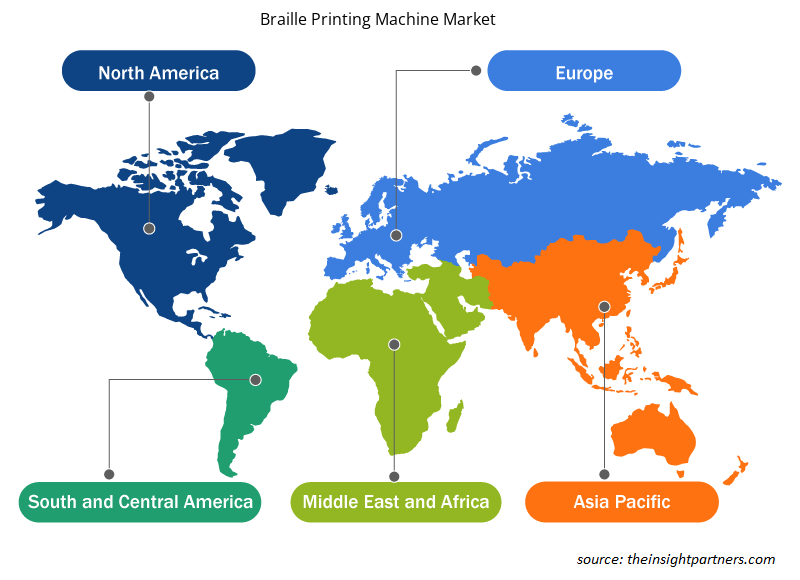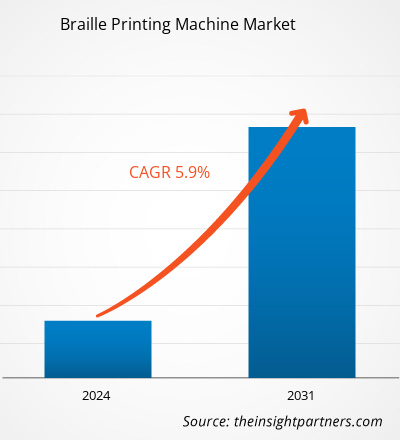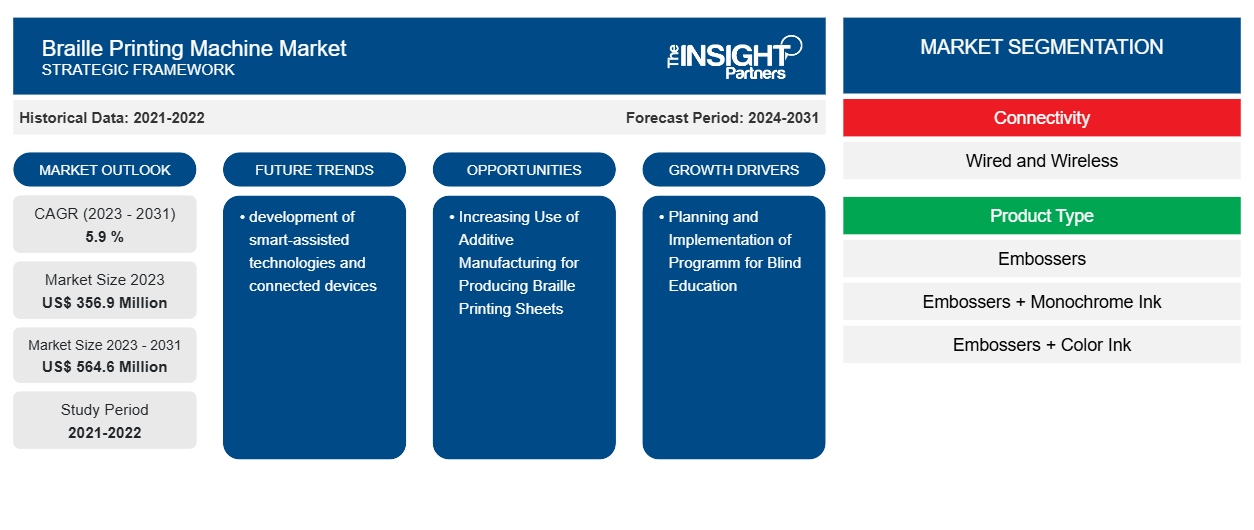Si prevede che la dimensione del mercato delle macchine da stampa braille raggiungerà i 564,6 milioni di dollari entro il 2031, rispetto ai 356,9 milioni di dollari del 2023. Si prevede che il mercato registrerà un CAGR del 5,9% nel periodo 2023-2031. È probabile che lo sviluppo di tecnologie assistite da smart e dispositivi connessi rimanga una tendenza chiave nel mercato.
Analisi di mercato delle macchine da stampa Braille
La macchina per la stampa braille è una stampante collegata a un computer che viene utilizzata per produrre una copia braille del testo. Una stampante braille può anche essere collegata a dispositivi per prendere appunti braille per lo stesso scopo. Con l'uso di una stampante braille, uno studente può stampare una copia braille dei propri appunti e del proprio lavoro di scrittura. Le stampanti braille richiedono carta pesante e la maggior parte dei modelli stampa su un solo lato.
Panoramica del mercato delle macchine da stampa Braille
Le stampanti Braille ricevono informazioni dai dispositivi informatici e le imprimono in Braille sulla carta tramite l'uso di solenoidi che controllano i perni di stampaggio. Le stampanti Braille in genere utilizzano più pagine per la stessa quantità di informazioni rispetto alle pagine stampate su una stampante normale. Le stampanti Braille, note anche come stampanti Braille, possono rendere molto più facile per i non vedenti stampare documenti leggibili se si ha una disabilità visiva. Dai documenti importanti alle copie di backup di lettere e moduli, una stampante Braille può essere un'utile aggiunta alla vita di tutti i giorni.
Personalizza questo report in base alle tue esigenze
Riceverai la personalizzazione gratuita di qualsiasi report, comprese parti di questo report, o analisi a livello nazionale, pacchetto dati Excel, oltre a usufruire di grandi offerte e sconti per start-up e università
-
Scopri le principali tendenze di mercato in questo rapporto.Questo campione GRATUITO includerà analisi di dati che spaziano dalle tendenze di mercato alle stime e alle previsioni.
Driver e opportunità del mercato delle macchine da stampa Braille
Pianificazione e attuazione del programma per l'istruzione dei ciechi a favore del mercato
La NFB BELL Academy offre ai bambini con abilità Braille e non visive una formazione attraverso attività di apprendimento divertenti e pratiche. A seconda della sede, le attività vengono fornite in un programma giornaliero o in una sede residenziale. Il programma è progettato per bambini ciechi e ipovedenti dai quattro ai dodici anni. Scopri di più sulla NFB BELL Academy. Tuttavia, Advocacy and Awareness, The National Association for the Blind Delhi, si impegna in sforzi di advocacy per aumentare la consapevolezza sull'importanza dell'istruzione inclusiva e per sostenere politiche che supportino i diritti degli studenti ipovedenti a ricevere un'istruzione di qualità in contesti tradizionali. Tali iniziative guidano la crescita del mercato a livello globale.NFB BELL Academy offers children with Braille and non-visual skills training through fun, hands-on learning activities. Depending on the location, activities are provided in a day program or residential location. The program is designed for blind and low-vision children ages four through twelve. Learn more about the NFB BELL Academy. However, Advocacy and Awareness, The National Association for the Blind Delhi, engages in advocacy efforts to raise awareness about the importance of inclusive education and to advocate for policies that support the rights of visually impaired students to receive quality education in mainstream settings. Such initiatives globally drive the growth of the market.
Utilizzo crescente della produzione additiva per la produzione di fogli di stampa Braille
La stampa Braille aiuta le persone cieche e ipovedenti a leggere, motivo per cui viene utilizzata ovunque. La stampa Braille sulle confezioni aiuta le persone cieche a orientarsi meglio e a ottenere informazioni. In particolare nel caso di confezioni per medicinali, si applicano obblighi di etichettatura speciali, anche in Braille. Grazie alla sua enorme applicazione, la produzione additiva viene utilizzata per produrre fogli di stampa Braille. Pertanto, aumentare l'uso della produzione additiva per la produzione di fogli di stampa Braille crea un'opportunità redditizia per la crescita del mercato.
Analisi della segmentazione del rapporto di mercato delle macchine da stampa Braille
I segmenti chiave che hanno contribuito alla derivazione dell'analisi di mercato delle macchine da stampa Braille sono connettività, tipo di prodotto, applicazione e settore.
- In base alla connettività, il mercato delle macchine da stampa Braille è suddiviso in cablate e wireless.
- In base al tipo di prodotto, il mercato delle macchine per la stampa Braille è suddiviso in goffratrici, goffratrici + inchiostro monocromatico e goffratrici + inchiostro a colori.
Analisi della quota di mercato delle macchine da stampa Braille per area geografica
L'ambito geografico del rapporto di mercato sulle macchine da stampa braille è suddiviso principalmente in cinque regioni: Nord America, Asia Pacifico, Europa, Medio Oriente e Africa e Sud e Centro America. Organizzazioni e individui in tutto il mondo hanno sostenuto una maggiore consapevolezza e accessibilità ai materiali e alla tecnologia braille. Nel 2021, sostenitori ed esperti in Camerun hanno celebrato la Giornata mondiale del braille (4 gennaio) con attività e un raduno. I giornalisti hanno osservato che "i dimostranti ciechi hanno affermato che il sistema braille li aiuta a migliorare la loro istruzione, a stabilire la loro indipendenza e a ridurre la necessità di supporto" e hanno chiesto un maggiore supporto per gli educatori affinché apprendano "il braille negli istituti di formazione degli insegnanti".
Approfondimenti regionali sul mercato delle macchine da stampa Braille
Le tendenze regionali e i fattori che influenzano il mercato delle macchine da stampa Braille durante il periodo di previsione sono stati ampiamente spiegati dagli analisti di Insight Partners. Questa sezione discute anche i segmenti e la geografia del mercato delle macchine da stampa Braille in Nord America, Europa, Asia Pacifico, Medio Oriente e Africa e America meridionale e centrale.

- Ottieni i dati specifici regionali per il mercato delle macchine da stampa Braille
Ambito del rapporto di mercato sulle macchine da stampa Braille
| Attributo del report | Dettagli |
|---|---|
| Dimensioni del mercato nel 2023 | 356,9 milioni di dollari USA |
| Dimensioni del mercato entro il 2031 | 564,6 milioni di dollari USA |
| CAGR globale (2023-2031) | 5,9% |
| Dati storici | 2021-2022 |
| Periodo di previsione | 2024-2031 |
| Segmenti coperti |
Per connettività
|
| Regioni e Paesi coperti |
America del Nord
|
| Leader di mercato e profili aziendali chiave |
|
Densità dei giocatori del mercato delle macchine da stampa Braille: comprendere il suo impatto sulle dinamiche aziendali
Il mercato delle macchine da stampa Braille sta crescendo rapidamente, spinto dalla crescente domanda degli utenti finali dovuta a fattori quali l'evoluzione delle preferenze dei consumatori, i progressi tecnologici e una maggiore consapevolezza dei vantaggi del prodotto. Con l'aumento della domanda, le aziende stanno ampliando le loro offerte, innovando per soddisfare le esigenze dei consumatori e capitalizzando sulle tendenze emergenti, il che alimenta ulteriormente la crescita del mercato.
La densità degli operatori di mercato si riferisce alla distribuzione di aziende o società che operano in un particolare mercato o settore. Indica quanti concorrenti (operatori di mercato) sono presenti in un dato spazio di mercato in relazione alle sue dimensioni o al valore di mercato totale.
Le principali aziende che operano nel mercato delle macchine da stampa Braille sono:
- Termoformatura americana
- Baumer HHS GmbH
- Gruppo Humanware
- Indice Braille
- Società anonima Nippon Telesoft Co. Ltd.
- Harpo sp. ZOO
Disclaimer : le aziende elencate sopra non sono classificate secondo un ordine particolare.

- Ottieni una panoramica dei principali attori del mercato delle macchine da stampa Braille
Notizie e sviluppi recenti sul mercato delle macchine da stampa Braille
Il mercato delle macchine da stampa braille viene valutato raccogliendo dati qualitativi e quantitativi dopo la ricerca primaria e secondaria, che include importanti pubblicazioni aziendali, dati associativi e database. Di seguito sono elencati alcuni degli sviluppi nel mercato delle macchine da stampa braille:
- Tecnovisão e HumanWare stipulano una partnership di distribuzione in Brasile. Questa partnership consentirà a HumanWare di condividere le sue innovative soluzioni per cecità e ipovisione con un numero maggiore di clienti in Brasile.
(Fonte: Tecnovisão, aprile 2021)
- Zychem Limited, in collaborazione con la sua società madre, American Thermoform, è lieta di presentare Swell Form Pro, una macchina grafica tattile all'avanguardia utilizzata per creare prodotti didattici per non vedenti e ipovedenti.
(Fonte: Zychem Limited, giugno 2024)
Copertura e risultati del rapporto sul mercato delle macchine da stampa Braille
Il rapporto "Dimensioni e previsioni del mercato delle macchine da stampa Braille (2021-2031)" fornisce un'analisi dettagliata del mercato che copre le seguenti aree:
- Dimensioni e previsioni del mercato delle macchine da stampa Braille a livello globale, regionale e nazionale per tutti i segmenti di mercato chiave coperti dall'ambito
- Tendenze del mercato delle macchine da stampa Braille, nonché dinamiche di mercato quali driver, restrizioni e opportunità chiave
- Analisi dettagliata delle cinque forze PEST/Porter e SWOT
- Analisi di mercato delle macchine da stampa Braille che copre le principali tendenze del mercato, il quadro globale e regionale, i principali attori, le normative e i recenti sviluppi del mercato
- Analisi del panorama industriale e della concorrenza che copre la concentrazione del mercato, l'analisi della mappa di calore, i principali attori e gli sviluppi recenti nel mercato delle macchine da stampa Braille
- Profili aziendali dettagliati
- Analisi storica (2 anni), anno base, previsione (7 anni) con CAGR
- Analisi PEST e SWOT
- Valore/volume delle dimensioni del mercato - Globale, Regionale, Nazionale
- Industria e panorama competitivo
- Set di dati Excel
Report recenti
Rapporti correlati
Testimonianze
Motivo dell'acquisto
- Processo decisionale informato
- Comprensione delle dinamiche di mercato
- Analisi competitiva
- Analisi dei clienti
- Previsioni di mercato
- Mitigazione del rischio
- Pianificazione strategica
- Giustificazione degli investimenti
- Identificazione dei mercati emergenti
- Miglioramento delle strategie di marketing
- Aumento dell'efficienza operativa
- Allineamento alle tendenze normative























 Ottieni un campione gratuito per - Mercato delle macchine da stampa Braille
Ottieni un campione gratuito per - Mercato delle macchine da stampa Braille